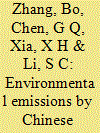|
|
|
Sort Order |
|
|
|
Items / Page
|
|
|
|
|
|
|
| Srl | Item |
| 1 |
ID:
113456


|
|
|
|
|
| Publication |
2012.
|
| Summary/Abstract |
For Chinese industry, the costs of different energy consumption abatement scenarios are evaluated by the method of directional distance function. These scenarios are based on the combinations of regulation strategies and allocation alternatives-the former are sectors and provinces, and the latter include the five principles of average, intensity share, absolute share, discriminatory absolute and discriminatory intensity. For all the scenarios, the quantitative impacts in terms of output potential loss are calculated and compared. Due to less output potential loss for all the allocation alternatives, the sector regulation strategy is shown to be more effective than the province regulation strategy. It is also demonstrated that, among all the scenarios considered, the sector regulation based on the intensity share principle and the province regulation based on the absolute share principle are the two optimal. The performances of energy abatement allocation of the 11th and 12th Five Year Plans of China are assessed against the simulated scenarios.
|
|
|
|
|
|
|
|
|
|
|
|
|
|
|
|
| 2 |
ID:
105770


|
|
|
|
|
| Publication |
2011.
|
| Summary/Abstract |
For the Chinese industry as the mainstay of the national economy and dominant energy user and carbon emitter, an integrative assessment is performed from major energy policy perspectives of energy security, energy efficiency and carbon emission. Extensive systems indicators, including oil dependence ratio, average oil growth rate; indices of energy diversity, of carbonization and of oil growth risk; ratios of energy use to output, to value added and to compensation for laborers; ratios of carbon emission to output, to value added and to compensation for laborers, are devised to assess the Chinese industry 2002-2007 with most recent statistics availability. Combined indicators are identified by sparse principle component analysis to characterize sector performances. The industrial sectors are classified into five clusters and the main features of each cluster are pinpointed using fuzzy clustering algorithm. Concrete results facilitate comparisons of sectors to enable more accurate policy recommendations.
|
|
|
|
|
|
|
|
|
|
|
|
|
|
|
|
| 3 |
ID:
113460


|
|
|
|
|
| Publication |
2012.
|
| Summary/Abstract |
Based on chemical exergy as an objective measure for the chemical deviation between the emission and the environment, a unifying assessment is carried out for major environmental emissions covering COD, ammonia nitrogen, SO2, soot, dust, NOx and solid waste by Chinese industry over 1997-2006, with emphasis on the sectoral and regional levels in 2006. Of the total emission in exergy up to 274.1 PJ in 2006, 67.7% is estimated from waste gases, 29.9% from waste water and 2.4% from solid waste. Five of 40 sectors and 12 of 30 regions are responsible for 72.7% and 65.5% of the total emission, respectively. SO2 is the leading emission type in 9 sectors and 25 regions, and COD in another 28 sectors and 5 regions. Some pollution-intensive sectors such as Production and Distribution of Electric Power and Heat Power and Manufacture of Paper and Paper Products, and western and inland regions such as Guangxi and Ningxia with high emission intensities are identified. By clustering and disjoint principal component analysis with intensities of emissions and fuel coal use as variables, three principal components are extracted, and four statistically significant clusters are pinpointed in the sectoral and regional analysis. Corresponding policy-making implications are addressed.
|
|
|
|
|
|
|
|
|
|
|
|
|
|
|
|
| 4 |
ID:
126616


|
|
|
|
|
| Publication |
2013.
|
| Summary/Abstract |
To systematically reveal how domestic trade impacts on China's regional energy uses, an interprovincial input-output modeling is carried out to address demand-derived energy requirements for the regional economies in 2007 based on the recently available data. Both the energy uses embodied in final demand and interregional trade are investigated from the regional and sectoral insights. Significant net transfers of embodied energy flows are identified from the central and western areas to the eastern area via interregional trade. Shanxi is the largest energy producer and interregional embodied energy deficit receiver, in contrast to Guangdong as the largest energy user and surplus receiver. By considering the impacts of interregional trade, the energy uses of most eastern regions increase remarkably. For instance, Shanghai, Hainan, Zhejiang, Beijing, Jiangsu and Guangdong have their embodied energy requirements 87.49, 19.97, 13.64, 12.60, 6.46 and 6.38 times of their direct energy inputs, respectively. In contrast, the embodied energy uses of some central and western regions such as Inner Mongolia, Shanxi, Xinjiang, Shaanxi and Guizhou decrease largely. The results help understand the hidden network linkages of interregional embodied energy flows and provide critical insight to amend China's current end-reduction-oriented energy policies by addressing the problem of regional responsibility transfer.
|
|
|
|
|
|
|
|
|
|
|
|
|
|
|
|
|
|
|
|
|